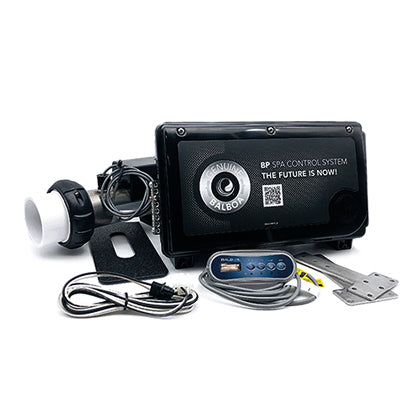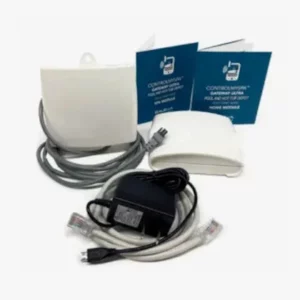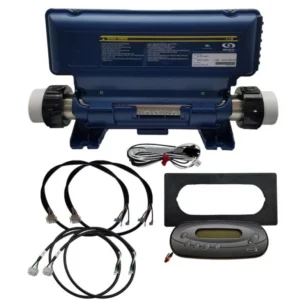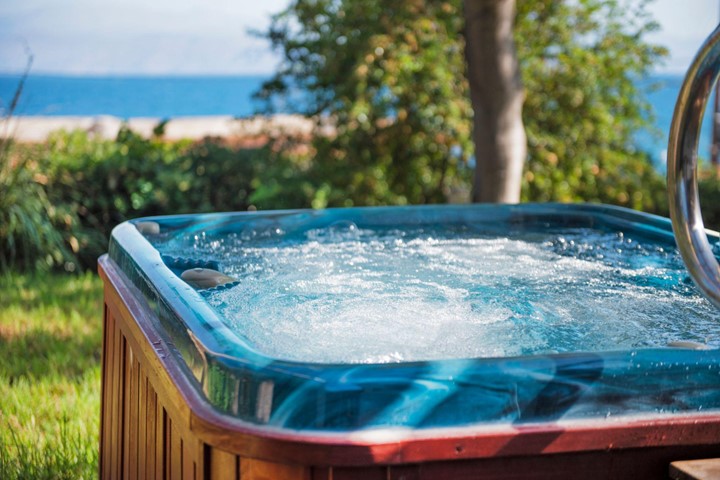
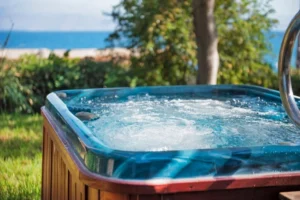
The circulation pump in a hot tub is responsible for maintaining water quality and ensuring the spa’s overall operation, which in some cases involves being the pump responsible for heating the water. It moves the water through a filtration system, which helps distribute heat evenly, prevent stagnation, and filter out impurities.
However, when the hot tub circulation pump isn’t turning on, makes strange noises, or simply isn’t working correctly, it can lead to various issues like the spa not heating, poor water circulation, compromised filtration, and damage to other spa components.
A hot tub circulation pump that doesn’t turn on is a common issue for hot tub owners, and it can stem from several underlying causes. Understanding these causes and how to troubleshoot them can help you resolve the problem on your own.
This article will explore the most common reasons for a hot tub circulation pump not working and provide practical solutions to help you get your spa running smoothly again.
Reasons and Solutions for a Hot Tub Circulation Pump Not Working
If your hot tub pump isn’t working properly, several issues could be causing the problem. These issues range from simple fixes like air in the lines to more complex problems. Addressing the reasons why your circulation pump isn’t working can help restore the spa’s functionality and ensure an enjoyable soaking experience.
Air in the lines/Circulation Pump
Air bubbles trapped in the circulation lines, also known as an airlock, can prevent the pump from priming and operating effectively.
Possible fixes include:
- Bleeding the lines: Start by turning the hot tub off. Then, open the air relief valve on the pump to release any trapped air. Allow the pump to run for a few minutes to purge the remaining air from the lines.
- Please see Immediately Purge Your Circulation Pump Air Lock
- Checking for leaks: Inspect the circulation lines for any leaks or loose fittings that allow air to enter the system. Repair any leaks and ensure all connections are tight to prevent further issues.
An airlock can also cause your jets to stop working correctly. Read more about troubleshooting hot tub jets.
Clogs
Another reason your tub circulation pump might not work is a clog. The accumulation of debris, dirt, or scale in the circulation system can lead to clogs, affecting the pump’s ability to circulate water.
Possible fixes for clogs include:
- Inspect and clean filters: Remove the hot tub filters and inspect them for debris or buildup. Clean the filters thoroughly to remove any contaminants. Replace the filters if they’re damaged or excessively worn.
- Clear blockages: Check the circulation lines, intake valves, and pump impeller for obstructions. Use a pipe cleaner or a jet line flush to clear out any debris or scale buildup.
- Flush the system: Consider flushing the entire circulation system with a dedicated cleaner to remove stubborn clogs and buildup. Follow the manufacturer’s instructions for the proper use of cleaner.
Defective Pump
Over time, the bearings in the circulation pump can wear out or become damaged, leading to malfunctioning.
Possible fixes for this include:
- Replace the pump: If you suspect the pump is defective, you may need to replace it. We recommend consulting a professional technician for this task unless you have experience.
- Please see Installing a New E10 Series Circulation Pump for installation instructions for a Dimension One circulation pump.
- Check for motor damage: Inspect the pump motor for any signs of damage or wear that may have contributed to the failure.
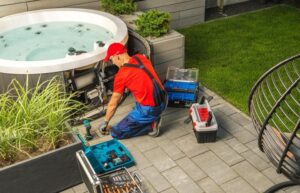
Troubleshooting Your Hot Tub’s Circulation Pump
Hot tub pump troubleshooting can help you identify issues and ensure proper spa functionality. Whether you suspect a problem or want to perform routine maintenance, knowing how to test the circulation pump can help you diagnose and address any issues. Here’s how to test a circulator pump:
- Turn off the power: Before performing any tests or maintenance on your hot tub and wiring a spa pump, always ensure the power supply is off at the breaker panel to ensure your safety and the integrity of the equipment.
- Locate the circulation pump: The circulation pump in your spa is typically located near the equipment area and is connected to the filter system.
- Check for obstructions: Before testing the pump, inspect it for any visible obstructions or signs of damage. Clear away any debris or obstacles that might hinder its performance.
- Listen for sounds: Turn the power back on and listen for any unusual sounds coming from the pump. A humming noise may indicate the pump is receiving power but won’t start. Meanwhile, a grinding noise may indicate bad bearings.
- Check for water flow: If the pump appears to be running but you’re unsure if water is flowing properly, observe the flow through the pump hose or check the circulation jets in the hot tub. A lack of water flow could indicate a blockage in the circulation lines or a malfunctioning impeller.
- Inspect the pump: If you suspect a blockage or mechanical issue, you may need to inspect the pump more closely or replace it. Turn off the power and carefully remove the pump housing to access this component. Check for any signs of debris or damage that may affect its operation.
Tips for Maintaining Your Hot Tub Circulation Pump
Maintaining your hot tub circulation pump is the best way to keep it in good working condition. Here’s how you can perform proper maintenance to ensure optimal performance and prolong the circulation pump’s lifespan:
- Keep the filter clean: Regularly clean and replace your hot tub filters according to the manufacturer’s recommendations. Dirty filters can restrict water flow and cause the pump to work harder, increasing wear and tear.
- Flush the system: Periodically flush the entire circulation system with clean water to remove any debris or scale. This prevents clogs and ensures optimal water flow throughout the system.
- Inspect for leaks: Routinely inspect the circulation pump, fittings, and connections for any signs of leaks. Addressing leaks can prevent water damage and prolong the lifespan of the pump and other components.
- Protect from freezing: If you live in a cold climate, take measures to winterize your hot tub and circulation pump from freezing.
- Schedule professional inspections: Consider scheduling regular maintenance inspections with a qualified hot tub technician. They can identify and address any potential issues early on, saving you time and money on repairs.

Hot Tub Circulation Pump Not Turning On FAQs
How do I know if my hot tub circulation pump isn’t working?
Several signs indicate your hot tub circulation pump isn’t working properly, including:
- Lack of water movement or circulation in the tub
- The Spa is not heating.
- Unusual noises coming from the pump, like grinding or humming
- Inconsistent water temperature or difficulty maintaining desired heat levels
- Hot tub error codes on the control panel like FLO, FLC, HL, etc.
- Visual signs of damage, leaks, or other issues with the pump
Here’s how to tell if a hot tub circulation pump is working:
- Water movement and circulation
- The spa is heating (if it uses a circulation pump for heat)
- Operational sounds like a low hum
- Good water flow
- Even heat distribution
Do you need a circulation pump in a hot tub?
In many cases, a circulation pump is the main pump for heating the Spa water. This makes it essential for maintaining water quality, distributing heat evenly, and ensuring effective filtration in a hot tub. Without a circulation pump, water would become stagnant, leading to poor water quality, increased risk of algae growth, and potential damage to the hot tub components. In some cases, the circulation pump is used only for the ozone system, so if it fails, the ozone will not work.
Is it easy to replace a malfunctioning hot tub circulation pump?
Replacing a malfunctioning hot tub circulation pump may be easy for some, but not others. It depends on your mechanical skills, the accessibility of the pump, and your spa’s specific model. While you may feel comfortable replacing the pump yourself, others may prefer to hire a professional hot tub technician for the task.
Keep Your Circulation Pump Running Smoothly
Ensuring your hot tub’s circulation pump is in good working order is essential for enjoying a relaxing soak without worries. You can keep your hot tub’s circulation system running smoothly by understanding common issues, troubleshooting techniques, and maintenance tips.
If you ever need to replace your hot tub circulation pump or other spa components, consider Easy Spa Parts for convenient access to high-quality replacement pumps and parts. With the proper care and attention, you can continue enjoying the benefits of your hot tub for many seasons.





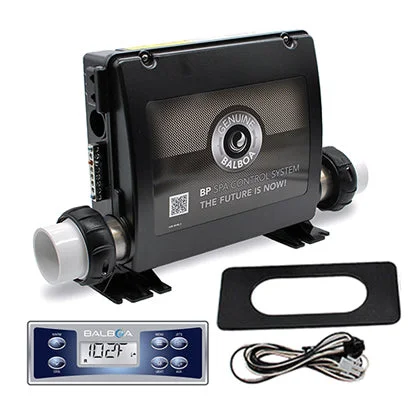
 2. Cost: Even if the
2. Cost: Even if the 